The deep divide between the quality of textbooks prescribed by elite schools affiliated with pan-India and offshore exam boards such as CISCE, CBSE, CIE (UK) and IB (Geneva) and the slapdash and sub-standard textbooks imposed upon the majority of hapless children enrolled in schools affiliated with the 31 state exam boards, is wrecking K-12 education and dividing India – Summiya Yasmeen
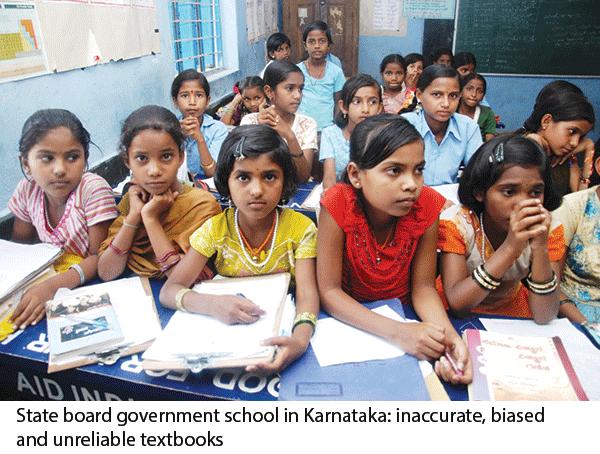 Already suffering the disadvantages of crumbling infrastructure, ill-qualified and untrained teachers, poor learning outcomes, teacher truancy, and obsolete curriculums, India’s 260 million children in K-12 education — the world’s largest school-going child population — are confronted with a new calamity. Across the country, a flood tide of haphazardly authored and prescribed error-ridden textbooks is adding to the burden of Indian school-goers struggling to keep up with their international counterparts.
Already suffering the disadvantages of crumbling infrastructure, ill-qualified and untrained teachers, poor learning outcomes, teacher truancy, and obsolete curriculums, India’s 260 million children in K-12 education — the world’s largest school-going child population — are confronted with a new calamity. Across the country, a flood tide of haphazardly authored and prescribed error-ridden textbooks is adding to the burden of Indian school-goers struggling to keep up with their international counterparts.
According to The Economist (June 8, 2017), India’s best 15-year-olds are unlikely to fare better than the bottom 2 percent of an American public school class. Despite this, the great majority of India’s school children — especially in 1.1 million government schools — who began school in June-July are being force-fed inaccurate, erroneous, biased and unreliable textbooks.
In Karnataka, 10.55 million children enrolled in 76,000 state board-affiliated schools including 12,289 English-medium schools have been presented newly printed texts for the academic year 2017-18, filled with an estimated 200 egregious errors including factual inaccuracies, spelling mistakes, missing diagrams and questions/answers. For instance in the class VII Kannada language textbook, pages 24-57 are missing altogether, while in the class X English textbook, pages 53-84 are printed upside down, and badminton ace P.V. Sindhu’s feat of winning a silver medal at the Rio Olympics has been downgraded to a bronze medal.
In Maharashtra, teachers have highlighted several factual gaffes in classes VIII and IX social science texts prescribed by the Maharashtra State Board of Secondary & Higher Secondary Education. The class XII sociology textbook ascribes “ugliness and handicap” as the main reasons why Indian parents have to pay high dowries (banned by law) for the marriage of their daughters. In Gujarat, a primary Hindi textbook describes Jesus Christ as a demon and roza (fasting by Muslims during the holy month of Ramzan) as an infectious disease.
Reports from other states of the Indian Union are on a par. The quality of texts published and printed by Soviet-style state government textbook committees across the country for students enrolled in 1.4 million state board-affiliated public and private schools is going from bad to worse.
The causes of this malaise run deep and are rooted in official corruption for which India is globally infamous. Starting from appointment of textbook committees, selection of writers and proof-readers to awarding printing contracts to private publishers, the State-controlled textbook production process is mired in nepotism and corruption. Politicians, officials and educrats of state governments pack textbook selection and commissioning committees with unqualified kith and kin who award writing and printing contracts to a growing number of small-time, fly-by-night authors, printers and publishers who have contributed heavily to dumbing down Indian education standards to rock-bottom depths.
The almost informally run textbooks selection, commissioning, printing and publishing system for schools affiliated with the country’s 31 state education boards doesn’t receive much public attention as the media is dominated by the upper middle class, which sends its children to the estimated 2,800 primary-secondaries affiliated with private exam boards such as CISCE (Delhi), IB (Geneva) and CIE (UK) which are much more mindful of the quality of textbooks they prescribe and commission. Ditto the Central Board of Secondary Education (CBSE) — India’s largest pan-India school examinations board with 18,694 schools including 13,657 private schools affiliated with it. Although CBSE is administered by the Union human resource development (HRD) ministry, and affiliated schools are advised to use textbooks printed and published by the HRD ministry-governed National Council of Educational Research & Training (NCERT), the quality of textbooks published by the council is widely acceptable.
However, given that textbooks are a mandatory requirement of schooling and assuming each one of the 260 million in-school children requires a modest five textbooks per year at an average price of Rs.25, the national market for textbooks aggregates a staggering Rs.26,000 crore. This huge market and commercial benefits thereof, have prompted state governments to make it their business to play a role in textbooks commissioning, printing and publishing. Moreover, it also offers opportunity to propagate sub-nationalism and the ideology of ruling parties. In 2016-17, the Karnataka Textbook Society printed 60 million textbooks at a cost of Rs.144 crore to the state exchequer. Also scrambling for a slice of this market are thousands of private book publishers and self-styled authors with dubious qualifications.
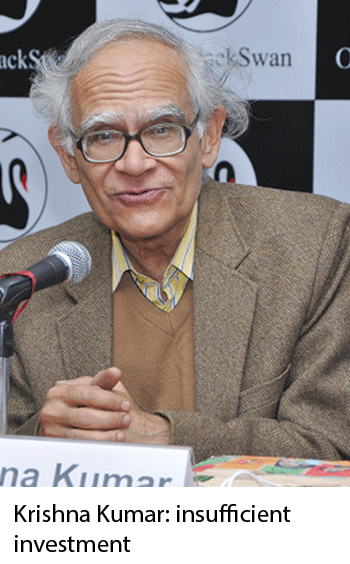 “Most state governments don’t invest sufficient resources — financial, technical and academic — that the production of high quality textbooks require. The temptation to infuse the ideology of ruling parties is another factor responsible for the poor quality of textbooks. Outsourcing doesn’t help as most private publishers are also producing poor quality textbooks,” says Dr. Krishna Kumar, the legendary former professor of education at Delhi University and former director of NCERT, who famously — through 16 focus groups — engineered the National Curriculum Framework 2005, widely regarded as the best-ever national curriculum guideline formulated in the history of Indian education. Alas! the framework hasn’t been implemented by state governments in spirit.
“Most state governments don’t invest sufficient resources — financial, technical and academic — that the production of high quality textbooks require. The temptation to infuse the ideology of ruling parties is another factor responsible for the poor quality of textbooks. Outsourcing doesn’t help as most private publishers are also producing poor quality textbooks,” says Dr. Krishna Kumar, the legendary former professor of education at Delhi University and former director of NCERT, who famously — through 16 focus groups — engineered the National Curriculum Framework 2005, widely regarded as the best-ever national curriculum guideline formulated in the history of Indian education. Alas! the framework hasn’t been implemented by state governments in spirit.
The country’s largest textbook publisher is NCERT, promoted in 1961 by the Union HRD ministry to research and periodically devise a national school curriculum and provide advice on pedagogic matters in school education. However, given the federal structure of the country, state exam boards aren’t obliged to strictly follow the NCERT national curriculum framework/texts.
The country’s 29 states have set up their own boards of education, State Councils of Educational Research and Training (SCERT) and textbook boards/societies to prescribe syllabuses and publish textbooks on the argument that textbooks and curriculums should be localised so that children learn about the history, geography, language and culture of the states they inhabit. Moreover, after state boundaries were redrawn on linguistic lines in 1956, state-level politicians professing love of their vernacular languages, were quick to discern the advantages of enforcing regional languages as the medium of instruction and awarding textbook printing contracts to kith, kin and cronies for captive consumption by millions of children in free-of-charge public schools affiliated with state boards.
Unfortunately, decentralisation of textbooks printing and curriculum formulation has gone too far and degenerated into flourishing textbooks commissioning and publishing rackets. For instance in Karnataka, the Department of State Educational Research and Training (DSERT) selects subject experts who constitute the textbook review committee (TRC) whose members write/revise K-12 textbooks in each subject. Critically, membership of the TRC is subject to the veto and/or amendment of the education minister, a party politician.
Any university professor or primary-secondary teacher with ten years’ experience can be appointed to serve on the TRC. No tests or interviews are conducted to check the capability of TRC members who write, revise, proof-read and finalise textbooks for each subject following DSERT guidelines. And given that TRC members are paid a measly Rs.3,000 for writing/revising the textbooks prescribed by the Karnataka Secondary Education Examination Board (KSEEB) for its 76,000 affiliated schools, the authors of these texts tend to be retired professors/teachers and graduates of obscure provincial universities with merely formal if not dubious qualifications.
Little wonder that an unusually high number of flagrant errors were found in the 60 million free-of-charge textbooks commissioned, printed and prescribed for the 10.55 million children in KSEEB-affiliated schools. The texts prepared and reviewed by 27 committees comprising 170 members headed by Kannada litterateur Baragur Ramachandrappa over two years have over 200 egregious errors — let alone confusing and inadequate explanations — according to a team of experts appointed by the ministry of education.
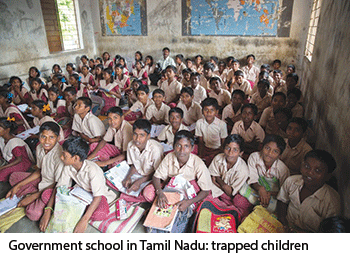 “The poor quality of authors included in TRCs is the weakest link of the textbook production process. It’s well-known that writers are appointed because of their political linkages rather than their subject expertise. Political parties in power reward their cronies and kith and kin with textbook writing and printing contracts. Consequently they are neither qualified to write, edit or proof-read resulting in error-ridden texts which are dumped on poor children obliged to study in free government schools as well as in 25,476 private schools including 12,289 English-medium schools affiliated with KSEEB. The indifference and callousness of state governments — which offer English and vernacular medium K-12 education — to textbook quality has resulted in poor learning outcomes, blighting the future of millions of children enrolled in state board schools across the country,” says Dr. A.S. Seetharamu, former professor of education at the Institute of Social and Economic Change, Bangalore.
“The poor quality of authors included in TRCs is the weakest link of the textbook production process. It’s well-known that writers are appointed because of their political linkages rather than their subject expertise. Political parties in power reward their cronies and kith and kin with textbook writing and printing contracts. Consequently they are neither qualified to write, edit or proof-read resulting in error-ridden texts which are dumped on poor children obliged to study in free government schools as well as in 25,476 private schools including 12,289 English-medium schools affiliated with KSEEB. The indifference and callousness of state governments — which offer English and vernacular medium K-12 education — to textbook quality has resulted in poor learning outcomes, blighting the future of millions of children enrolled in state board schools across the country,” says Dr. A.S. Seetharamu, former professor of education at the Institute of Social and Economic Change, Bangalore.
Inevitably, government control of the patently flawed and secretive textbook production process is defended by Narasimhaiah, the Bangalore-based director of DSERT. “We revise texts every five years and have set up a robust system of selecting knowledgeable authors who must be university professors or school teachers with at least ten years’ experience. The TRC studies NCERT texts and those of other states before finalising content. The final content is passed on to the Karnataka Textbook Society which invites tenders for printing from private printers. The errors mainly occur at the design and layout stage and are usually typographical. Even so, content experts make a list of corrections which is sent to all schools. Mistakes don’t just happen with DSERT textbooks, but also in the NCERT books,” says Narasimhaiah unconvincingly.
| State government texbook howlers
• An English-medium class XII sociology textbook of the Maharashtra State Board of Secondary & Higher Secondary Education ascribes “ugliness and handicap” as the main reasons why Indian parents have to pay dowry for the marriage of their daughters. “If a girl is ugly and handicapped, it becomes very difficult for her to get married. To marry her, the girl’s bridegroom and his family demand more dowry. The helpless parents of such girls are then forced to pay up,” explains the author. • A class IV environment science textbook prescribed by Delhi government schools advises students to kill a kitten as part of an experiment. “No living thing can live without air for more than a few minutes. You can do an experiment. Take two wooden boxes. Make holes on the lid of one box. Put a small kitten in each box. Close the boxes. After some time, open the boxes. What do you see? The kitten inside the box without holes has died,” reads the text. • A class IX Hindi textbook of the Rajasthan Board of Secondary Education compares a housewife to a donkey. “A donkey is like a housewife. It has to toil all day and, like her, may even have to give up food and water. In fact, the donkey is a shade better, for while the housewife may sometimes complain and walk off to her parents’ home, you’ll never catch the donkey being disloyal to his master.” • A class X social science textbook, published by the Chhattisgarh Board of Secondary Education, says unemployment has spiraled after independence as more women have started working. “Before Independence, few women were employed. But today, women are employed in all sectors that has increased the proportion of unemployment among men,” it reads. • A class IV Hindi textbook of the Gujarat State School Textbook Board defines the Urdu word “roza,” which denotes fasting during the holy month of Ramzan, as “an infectious disease that causes diarrhoea.” A class XI Hindi text describes Jesus Christ as a demon. • A class X English-medium physical education textbook of the Karnataka state board says badminton ace P.V. Sindhu “wone” bronze at the Rio Olympics in 2016 instead of silver, while badminton champion Saina Nehwal’s name is inter-changeable with that of Sania Mirza, the international tennis star. |
This practice of recklessly commissioning, printing and publishing sub-standard textbooks for hapless children trapped in state board schools is a countrywide phenomenon, and adversely impacts the learning outcomes of over 250 million children.
In Tamil Nadu, for instance, the DMK government (2006-2011) legislated the Uniform System of School Education Act 2010, abolishing the state’s four disparate (and competitive) school examination boards — the State, Matriculation, Anglo-Indian and Oriental school boards — and decreed a samacheerkalvi (common curriculum) and textbooks for classes I-X in all 53,000 government primary-secondaries, and 10,934 private matriculation schools, all of whom were forcibly affiliated with the Tamil Nadu State Board of School Education (TNSBSE).
Readily adopted by the Jayalalithaa-led AIADMK government, elected to power in 2011, the samacheerkalvi syllabus and textbooks have been heavily criticised by parents and teachers — especially of the Matriculation, Anglo Indian and Oriental schools — for poor quality. Following criticism of factual and spelling errors, and confusing explanations in samacheerkalvi textbooks, in November 2011, the Directorate of Teacher Education Research and Training (DTERT) marshalled 40,000 teachers to review and rewrite the textbooks. However, given the indiscriminate selection of authors and reviewers, TNSBSE’s common curriculum textbooks are unreliable and suffused with errors of fact and substance.
“We are not satisfied with the quality of common curriculum textbooks prescribed by the state government for children in classes I-X. Although texts are being revised every year, the core content is of poor quality. For instance, in the class IX physics textbook, the lesson on Vernier calipers does not provide even a basic explanation of the concept or a proper definition. The exercises at the end of the lesson are also not relevant to the subject, making it difficult for students to grasp the content. Moreover, most lessons are written in a dry and uninteresting style, and there are too many spelling mistakes. Therefore, while we are forced to use TNSBSE textbooks, we are supplementing them with better quality texts from reputed private publishers for the benefit of our students,” says Latha Ravi, principal of the TNSBSE-affiliated Sri Sankara Matriculation Higher Secondary School, Chennai.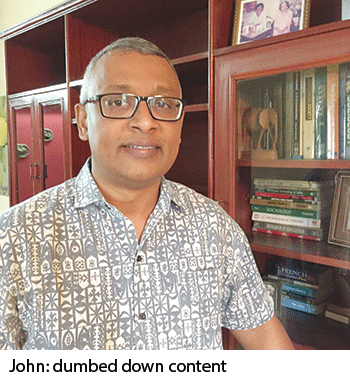
Given Tamil Nadu’s excellent reputation for high quality K-12 education in which parents had the choice of six competitive examination boards, why was a dumbed-down common curriculum and forcible affiliation to TNSBSE introduced? Quite obviously, to give state board students easy entry into the state’s engineering, medical and other professional colleges. Simultaneously, it enabled the notoriously corrupt DMK and AIADMK governments the opportunity to commission, print and publish common textbooks on a massive scale in return for kickbacks. But now the chickens are coming home to roost. School-leavers from TNSBSE schools are finding it increasingly difficult to crack national entrance exams such as IIT-JEE and NEET.
Likewise in Maharashtra (pop.112 million), India’s leading industrial state, textbooks commissioned, printed and published by the Maharashtra State Bureau of Textbook Production and Curriculum Research (MSBTPCR) under the brand name Balbharti for 22.4 million students enrolled in 68,000 schools affiliated with the Maharashtra State Board of Secondary and Higher Secondary Education (MSBSHSE), have come under severe criticism for shoddy authors selection and printing delays.
Comments Ivan John, sociology teacher at the Sophia College for Women, Mumbai, and a member of MSBSHSE’s Board of Studies (sociology) who was invited in 2013 to review and rewrite a class XI sociology text: “After I rewrote the sociology text together with two other teachers, our material was reviewed and rejected by a committee comprising members whose work we had been asked to review and rewrite. Most of the authors commissioned to write English medium textbooks don’t necessarily understand the nuances of the English language and the impact such content will have on young minds. Therefore errors creep in when Marathi-English and vice versa translation happens. Textbook writers tend to dumb down language and content on the pretext that rural and tribal students must understand it. I don’t see the textbook bureau radically changing systems and processes anytime soon. Therefore, the onus is on teachers to use multiple sources to ensure that children have a wider understanding of concepts and content.”
Moreover since the BJP triumphed at the Centre in General Election 2014, and in several state assemblies including Maharashtra, Rajasthan and Madhya Pradesh, inspired by its ideological mentor the Rashtriya Swayamsevak Sangh (RSS), the Centre has been appointing RSS intellectuals of questionable credentials to apex positions in academic institutions, such as the Indian Council of Historical Research and NCERT, from which positions they have been influencing history and social science texts. In 2015, the HRD ministry-controlled NCERT set the ball rolling to correct “errors” in history textbooks commissioned by the predecessor Congress-led UPA government. Among the “errors” rectified — the 2002 anti-Muslim riots in Gujarat have been modified to “Gujarat riots” in class XII history texts.
Moreover, recently NCERT director Hrushikesh Senapaty, appointed in 2015 by the BJP government, announced that the council will “review” all its texts and invited suggestions from the public. In response, RSS ideologue Dinanath Batra has sent a list of recommendations to NCERT. Among them: purge texts of all English, Urdu and Arabic words and remove a couplet by Urdu poet Mirza Ghalib, extracts from painter M.F. Husain’s autobiography, references to Mughal emperors as benevolent, and to the BJP as a Hindu party.
“The RSS and BJP are continuously working to whitewash their own misdeeds and brainwash our youth. Whenever they come to power or otherwise through intimidation, they try to falsify history and suppress diverse, liberal points of view. But facts are facts. Today, information can be counterchecked on the Internet, so the truth will be out. But they do a disservice to our children by inserting falsehoods and propaganda in textbooks. We will fight against these changes in multiple arenas and endeavour to prevent or reverse them,” says Rajeev Gowda, former professor at IIM-Bangalore and currently Member of Parliament and spokesperson of the Congress party.
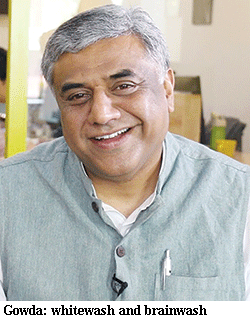 Out of power at the Centre and in the states for over half a century, RSS/BJP leaders and ideologues believe they have been forced to witness the distortion of Indian history and culture by ‘pseudo-secular’ historians and academics appointed by the Congress, which in the interests of ‘appeasement’ of the country’s 150 million-strong Muslim community and national unity, has suppressed the atrocities of over 300 years rule of Muslim invaders and forced conversion to Islam of millions of Hindus. Moreover, they accuse Congress court historians and academics of ignoring the glorious reign of the pre-Muslim period of Indian history. Therefore RSS/BJP leaders and intellectuals believe they have an obligation to correct the ‘distortions’ of history propagated by pseudo-secularist Congress and Left historians. However, the great majority of RSS-inspired historians lack the intellectual rigour and highly developed research and evidence accumulation skills of professional historians, and tend to mix up history with mythology.
Out of power at the Centre and in the states for over half a century, RSS/BJP leaders and ideologues believe they have been forced to witness the distortion of Indian history and culture by ‘pseudo-secular’ historians and academics appointed by the Congress, which in the interests of ‘appeasement’ of the country’s 150 million-strong Muslim community and national unity, has suppressed the atrocities of over 300 years rule of Muslim invaders and forced conversion to Islam of millions of Hindus. Moreover, they accuse Congress court historians and academics of ignoring the glorious reign of the pre-Muslim period of Indian history. Therefore RSS/BJP leaders and intellectuals believe they have an obligation to correct the ‘distortions’ of history propagated by pseudo-secularist Congress and Left historians. However, the great majority of RSS-inspired historians lack the intellectual rigour and highly developed research and evidence accumulation skills of professional historians, and tend to mix up history with mythology.
The RSS/BJP’s revision — described as saffronisation by critics — of school history and social science texts began in 1999 when a BJP coalition government led by Atal Bihari Vajpayee was elected to office in New Delhi. Under then HRD minister Murli Manohar Joshi, NCERT revised several K-12 history textbooks, projecting Hindu myths and legends as historical truths. Joshi’s saffronisation of school texts mission was brought to a halt by the unexpected election of the Congress-led UPA coalition at the Centre in 2004 which served two terms in office (2004-2014). But now with the election of the BJP in 2014, liberal academics fear that the revision and saffronisation of K-12 history and social science texts has resumed.
In BJP-ruled states, such as Gujarat, Madhya Pradesh, Rajasthan and Haryana, textbooks are being ‘revised’ with abandon. The Rajasthan State Textbook Board has erased all references to independent India’s first prime minister Jawaharlal Nehru in class VIII social science texts, and in Gujarat, Hindu my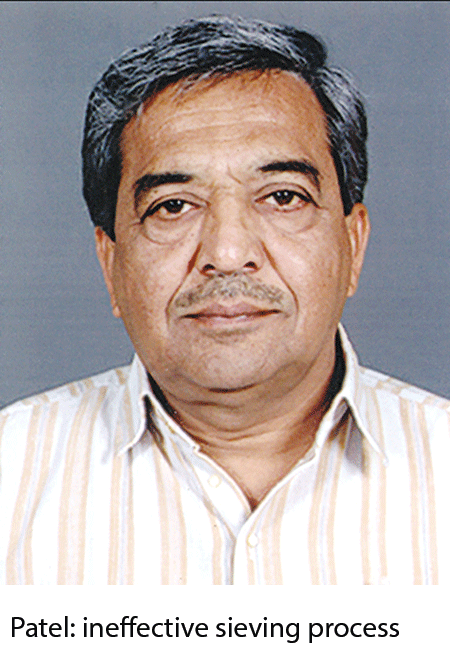 thology is being injected into history texts. A newly written class IX Hindi text of the Gujarat State School Textbook Board (GSSTB) refers to Jesus Christ as “demon,” and a class IV Hindi text describes roza — the month-long dawn-to-dusk fast undertaken by devout Muslims during the holy month of Ramzan — as “an infectious disease in which one suffers from diarrhoea and vomiting”.
thology is being injected into history texts. A newly written class IX Hindi text of the Gujarat State School Textbook Board (GSSTB) refers to Jesus Christ as “demon,” and a class IV Hindi text describes roza — the month-long dawn-to-dusk fast undertaken by devout Muslims during the holy month of Ramzan — as “an infectious disease in which one suffers from diarrhoea and vomiting”.
Even though local Christian and Muslim leaders have demanded recall of these texts, GSSTB is yet to issue a correction advisory. “It is possible that in the selection of writers or translators, people of a particular bent of mind have been inducted and they may have played mischief. The point, however, is that there is a stage-wise sieving process to prevent such mistakes. So what happened to it? How come such mistakes were not detected at these check points?” questions Ahmedabad-based Sukhdev Patel, an eminent educationist and child rights activist.
A set of eight ill-written revisionist books — an amalgam of the history and mythology of ancient Hindu India — authored by Dinanath Batra, founder of RSS-affiliated Shiksha Sanskriti Utthan Nyas, has been made compulsory reading in all 42,000 including English-medium primary-secondaries affiliated with the Gujarat Secondary and Higher Secondary Education Board. The books have been roundly criticised for their regressive content. For instance, in one of the books with a foreword by prime minister Narendra Modi, Batra writes that the Indian map should include Pakistan, Afghanistan, Nepal, Bhutan, Tibet, Bangladesh, Sri Lanka and Burma as they are all a part of Akhand Bharat. In another title Shikshan nu Bhartiyakaran (‘Indianisation of Education’), he advises against the universal celebration of birthdays with cakes and candles because it’s “western practice”.
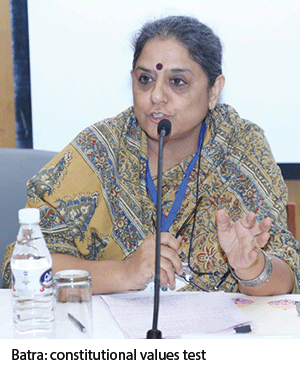 The way the BJP government in Gujarat has been tightening its tentacles around the education sector is a clear indicator of its intent to saffronise it. First, it tightened its stranglehold on college and university education through legislation. Thereafter it moved to shackle K-12 education in unaided private schools through prescribing tuition fee ceilings, and now it is polluting young, impressionable minds through sub-standard and biased textbooks. It is shameful,” says Dr. Manish Doshi, spokesperson of the Gujarat State Congress and former member of the Executive Council of Gujarat University.
The way the BJP government in Gujarat has been tightening its tentacles around the education sector is a clear indicator of its intent to saffronise it. First, it tightened its stranglehold on college and university education through legislation. Thereafter it moved to shackle K-12 education in unaided private schools through prescribing tuition fee ceilings, and now it is polluting young, impressionable minds through sub-standard and biased textbooks. It is shameful,” says Dr. Manish Doshi, spokesperson of the Gujarat State Congress and former member of the Executive Council of Gujarat University.
Dr. Poonam Batra, professor of education at Delhi University’s Central Institute of Education, warns that “attempts to revise textbooks with the aim to foreground ‘Indian culture’ could end up portraying a distorted picture of Indian society which is so diverse”. “The litmus test for any textbook writing is to ensure that texts are in consonance with the values enshrined in our Constitution and this is clearly stated in the preamble of the National Curriculum Framework (NCF) 2005. The NCF 2005 is a robust framework to develop school textbooks and states need to ensure that our Constitutional values are not violated in the process of adapting or modifying the school curriculum framework,” she says.
Quite clearly, there’s a deep divide between the quality of textbooks prescribed by the managements of pan-India and offshore exam boards such as CISCE, CBSE, CIE (UK) and IB (Geneva) for children in elite affiliated schools, and the slapdash, sub-standard and often incomprehensible textbooks commissioned, printed, published and imposed upon the majority 250 million hapless children in primary-secondary schools affiliated with 31 state exam boards. With the majority of them first generation learners lacking parental supervision of school texts, they struggle to make sense of sloppily written textbooks and in desperation, are driven to rote learning.
In sharp contrast, schools affiliated with CISCE and international exam boards viz. the International Baccalaureate, Geneva and Cambridge International Examinations, UK have the freedom to choose from long lists of textbooks published by highly reputed and experienced publishers. According to Gerry Arathoon, CEO and general secretary of CISCE, the board doesn’t publish or prescribe textbooks for affiliated schools, with school managements given full freedom to choose from recommended lists of privately published textbooks. This liberal textbooks policy is perhaps a major contributory factor for CISCE school students topping the National Achievement Survey 2015 of NCERT which assessed the unprepared learning outcomes of students of schools affiliated with 33 exam boards.
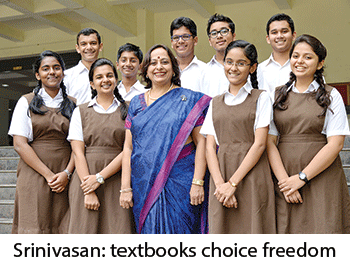 Comments Dr. Revathi Srinivasan, an alumna of Bombay and Delhi universities and director and principal of the CISCE-affiliated Smt. Sulochanadevi Singhania School, Thane (Mumbai) which has an aggregate enrolment of 6,500 students mentored by 360 teachers: “The CISCE board has given us full freedom to choose from among textbooks published by highly reputed private publishers. In our school in the primary and middle sections, we use textbooks sparingly with teachers creating most of the subject material. In classes VIII-XII our team of teachers and curriculum experts selects the best texts of private publishers mapped with the CISCE syllabus. Most of the time our teachers use two-three texts simultaneously and also supplement them with experiential projects.”
Comments Dr. Revathi Srinivasan, an alumna of Bombay and Delhi universities and director and principal of the CISCE-affiliated Smt. Sulochanadevi Singhania School, Thane (Mumbai) which has an aggregate enrolment of 6,500 students mentored by 360 teachers: “The CISCE board has given us full freedom to choose from among textbooks published by highly reputed private publishers. In our school in the primary and middle sections, we use textbooks sparingly with teachers creating most of the subject material. In classes VIII-XII our team of teachers and curriculum experts selects the best texts of private publishers mapped with the CISCE syllabus. Most of the time our teachers use two-three texts simultaneously and also supplement them with experiential projects.”
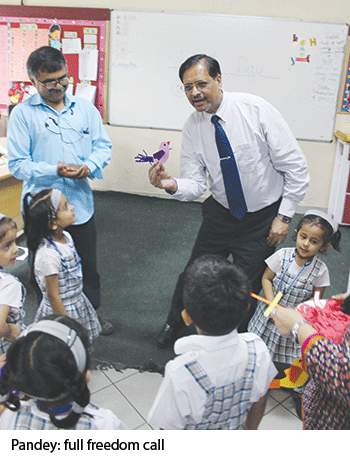 On the other hand, CBSE has recently advised its schools to restrict themselves to using NCERT textbooks. “Currently in primary school upto class VIII, most schools use texts of private publishers or their own learning material, but in secondary school because question papers of the class X and XII board exams are prepared using NCERT texts, most CBSE schools are obliged to use them. However, I strongly believe that CBSE schools must be given the freedom to use the best quality texts of any publisher — private or NCERT,” says Dr. Ashok Pandey, principal of the CBSE-affiliated Ahlcon International School, Delhi, echoing the rumblings of a revolt against CBSE among the 13,657 private independent affiliated schools (see EW cover story, February 2017). As we go to press, on July 30 the Madras high court stayed the CBSE circular restraining affiliated schools from using privately published texts.
On the other hand, CBSE has recently advised its schools to restrict themselves to using NCERT textbooks. “Currently in primary school upto class VIII, most schools use texts of private publishers or their own learning material, but in secondary school because question papers of the class X and XII board exams are prepared using NCERT texts, most CBSE schools are obliged to use them. However, I strongly believe that CBSE schools must be given the freedom to use the best quality texts of any publisher — private or NCERT,” says Dr. Ashok Pandey, principal of the CBSE-affiliated Ahlcon International School, Delhi, echoing the rumblings of a revolt against CBSE among the 13,657 private independent affiliated schools (see EW cover story, February 2017). As we go to press, on July 30 the Madras high court stayed the CBSE circular restraining affiliated schools from using privately published texts.
Indeed with a large number of reputed private publishers churning out thousands of subject textbooks annually (see box), objective monitors of Indian K-12 education wonder why it’s necessary for NCERT or state governments to produce school textbooks at all. Quite clearly, state involvement in the production of school textbooks is a hangover of the Soviet-inspired neta-babu licence-permit-quota regimen under which government ‘nation-building’ propaganda could be freely infused into school textbooks.
The “deep implications of the open, uninterrupted and continuous apartheid in Indian school education” sufficiently aroused EducationWorld editor Dilip Thakore from his hospital bed where he is recovering from a virulent fever to issue the following statement. “It’s shocking that the country’s supine academics and self-serving intellectuals haven’t protested the deep division between the quality of primary-secondary education being dispensed to a tiny elite in schools affiliated with pan-India and international exam boards such as CISCE, CBSE, IB, CIE etc, and the 31 state examination boards. In particular, it’s shameful CISCE and CBSE students have access to excellent, high quality textbooks while those of English-medium state board schools are obliged to study sub-standard textbooks written by B & C grade academics unfamiliar with the English language. Immediate steps should be taken to ensure quality equivalence by constituting textbook approval committees chaired by the vice chancellor and comprising eminent academics of the top-ranked universities in each state, without whose imprimatur no school textbooks should be printed or prescribed. There’s a direct connection between sub-standard textbooks prescribed by state examination boards and the rock-bottom productivity of Indian industry, agriculture and government,” says Thakore.
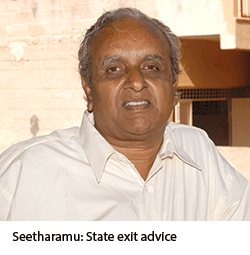 Little wonder that Dr. A.S. Seetharamu, former professor of education at the Institute of Social and Economic Change, Bangalore recommends that the Central and state governments should get out of textbooks production. “The government needs to denationalise textbook writing and production. Expert committees of reputed academics in each state should recommend the textbooks of highly reputed private publishers for bulk purchase and distribution to state board schools. Private textbook publishers have access to the whole country for quality writers and there is competition among them to commission, print and publish the best quality texts. This is the only way to bridge the division created in Indian society by poor quality texts dumped on children of the poor enrolled in government schools,” says Seetharamu.
Little wonder that Dr. A.S. Seetharamu, former professor of education at the Institute of Social and Economic Change, Bangalore recommends that the Central and state governments should get out of textbooks production. “The government needs to denationalise textbook writing and production. Expert committees of reputed academics in each state should recommend the textbooks of highly reputed private publishers for bulk purchase and distribution to state board schools. Private textbook publishers have access to the whole country for quality writers and there is competition among them to commission, print and publish the best quality texts. This is the only way to bridge the division created in Indian society by poor quality texts dumped on children of the poor enrolled in government schools,” says Seetharamu.
Quite clearly, there’s an urgent national imperative to restore balance and equivalence between the quality of primary-secondary education in schools affiliated with national (CISCE, CBSE) and offshore (IB, CIE, AP) exam boards and the 31 state exam boards. And an ideal starting point would be to end the great textbooks commissioning, printing and publishing rackets which have flourished in the states for half a century.
But with RSS/BJP ideologues seemingly intent on infusing their own spin and propaganda into school curriculums, the chances of this overdue reform being implemented are slim. Unless the country’s academics and intellectuals emerge from their ivory towers and unitedly and vigorously protest this patent injustice in Indian school education.
Top prviate textbooks publishers
| No. of titles in print | |
| Anmol Publishers | 10,000 |
| MBD Group | 8,000 |
| Navneet | 5000 |
| Pearson Education | 3000 |
| S. Chand | 2,800 |
| Oxford University Press | 2,500 |
| CBS Publishers | 2000 |
| Macmillan | 1,400 |
| Vikas Publishers | 1,200 |
| Pragati Prakashan | 856 |
| Arihant | 501 |
Source: EW compilation
With Dipta Joshi (Mumbai), Autar Nehru (Delhi), Odeal D’Souza (Bangalore) & Hemalatha Raghupathi (Chennai)























